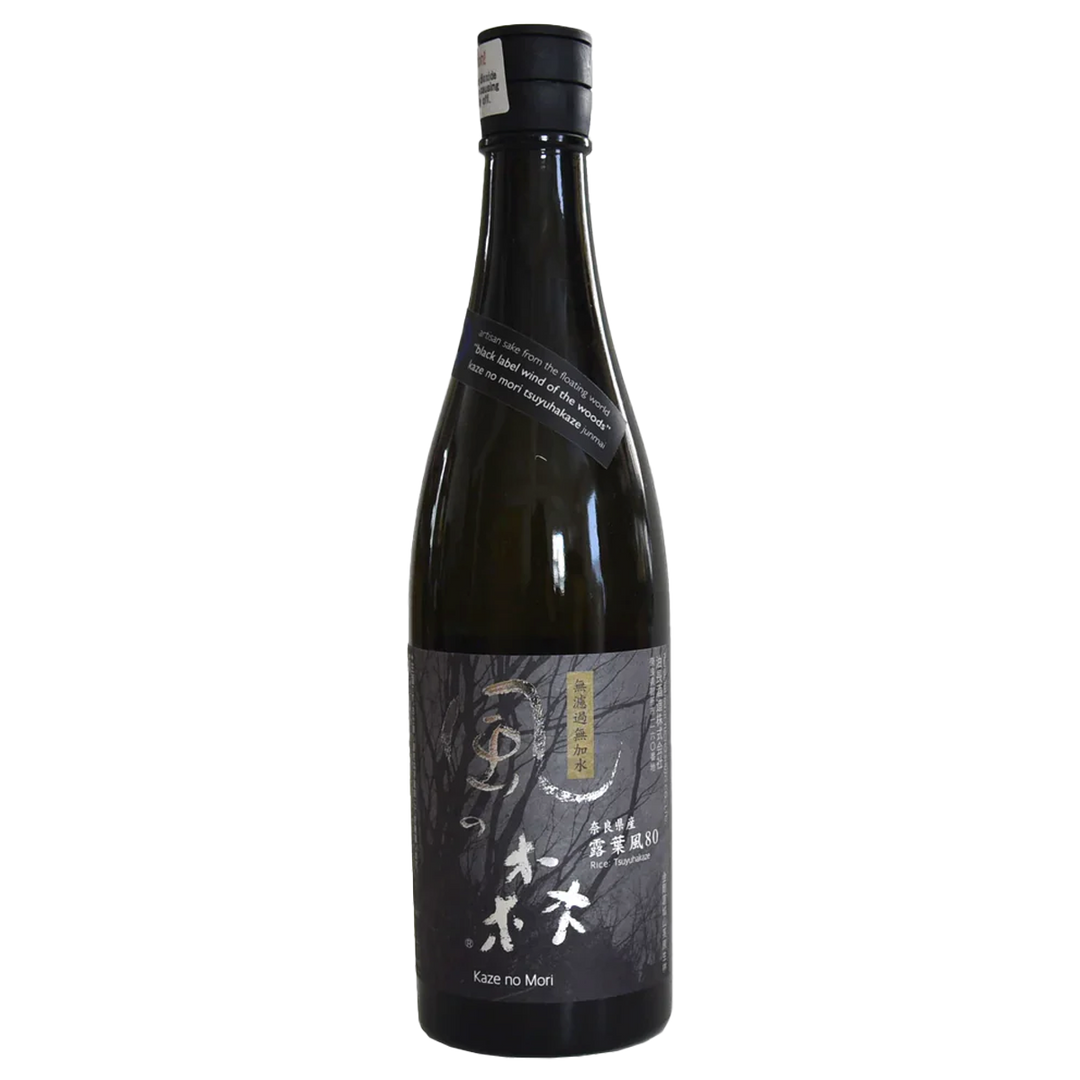
Kaze no Mori Tsuyuhakaze "Black Label 807" Junmai Muroka Nama Genshu
- Low stock - 1 item left
Tropical notes of ripe mango, muscat, baked pineapple, taffy-like bananas foster froyo, half-dried apricot, and jasmine tea. And yet, it’s neither too intensely aromatic nor sweet. There is a chewy density of fruit but a refreshing lightness at the same time. Chobei-san says it has toromii: richness, length, but not weight.
Dense, chewy, and yet light and refreshing, Kaze no Mori Tsuyuhakaze 807 is a testament to the unique brewing methods utilized by Yucho Shuzo and their ability to create tension between the low polish rice (80%--typically heavy, dense, umami-rich), the tight and coarse mineral-rich water, and the effervescent lightness of a freshly-pressed namazake.
Brewery: Yucho Shuzo
Brand: Kaze no Mori Black
Location: Gose City, Nara Prefecture
Water: mineral-rich, hard (250mg/l) Katsuragi Mountain well water, which requires strict low temperature control to ensure a slow fermentation.
Rice: Tsuyuhakaze (Nara)
Polishing: 80%
Grade: Junmai Muroka Nama Genshu
Yeast: #7
SMV: 0
Acidity: 2
Alcohol: 17%
Kaze no Mori means "wind of the woods" and is a regionality-driven, fresh and expressive line of sake introduced in 1998 by the 12th generation of Yucho Shuzo, Chobei Yamamoto. Releases are numbered (this is 657), and those numbers correspond to the variety of rice and yeast used in production (in this case, Akitsuho 65 & Yeast #7). Yucho Shuzo has been making sake and shochu since 1719, primarily under their first brand, Takacho (see: Takacho Regal Hawk) but faced a huge drop in demand during the 80s, forcing the brewery to reconsider its approach. At a small retail event in the 1990s Chobei tested a theory, and poured fresh-from-the-tap, unpasteurized, undiluted Takacho for guests. He knew that this ephemeral, fresh-pressed sake was one of the most delicious experiences you can have in a brewery, and at the event it was received with great enthusiasm, providing the impetus for his new Kaze no Mori brand. The improvements in refrigerated shipping that had taken place during the same era opened the door logistically to an otherwise unstable product.
Kaze no Mori is a divergence from traditional sake: younger, wilder, with signature flavors of melon and mint, intending to deliver the "straight from the press" experience to sake drinkers. The name "Kaze no Mori" refers to the wind that soars through the city of Gose in Nara Prefecture, home to the Kaze no Mori shrine which sits at the top of a local mountain pass. It also suggests freshness and new movement, which are integral to the brand's concept. The rice that grows at the top of this mountain pass is called Akitsuho, and it is the heart of both Gose and the Kaze no Mori brand.
Since 1998, Chobei and his son Yoshihiko have adapted daiginjo brewing techniques to the Kaze no Mori line, lending daiginjo-level aromatics, while low-polish Tsuyuhakaze rice (polished to 80%) lends astringent complexity, depth, and richness. The brewery utilizes a gravity flow system rather than pumps so that natural carbonation, flavor, and aroma are retained in the sake. The sake is filtered with a proprietary technology, a submerged press in the vat, in order to limit the liquid's movement. In addition, their custom bottling line (one of 2 in Japan) adjusts the level of the spout to the height of the liquid as it fills the bottle.
Achieving "just from the press" freshness when we open a bottle here in Portland, thousands of miles away from its origin in Nara prefecture, has been a technical feat and is a multi-generational process of refinement. Yoshihiko says, "This kind of product really is alive. Open it and it's like a flower. For the consumer to enjoy it at a meal while it's in the glory of its bloom, we have to make sure that it stays in bud, so to speak, during our production phases at the brewery and during transport." There is no other sake quite like it, and this evolution-- the blossoming which takes place right in front of your eyes-- is such a huge part of what makes Kaze no Mori special, and why I recommend appreciating its evolution at home.
But Yoshihiko insists this regionally inspired product is not a representation of terroir. "At its root, terroir has no relationship with the production process. The term was used in the wine world to describe the special characteristics of grapes depending on where and how they're grown. With sake, you have a process whereby you use the koji to convert the starches from rice into fermentable sugars....terroir just doesn't do any justice to the path we've taken here in Nara." Out of respect for Yoshihiko, I call this sake regionally representative. It inspires the spirit of Gose through its rice, its freshness and verve, and in being imbued with the wind-like essence of the Kaze no Mori pass.
59.52 YPR

